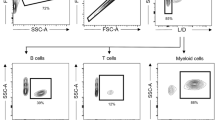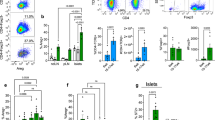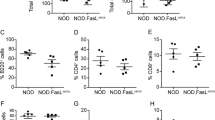Abstract
Fas ligand is believed to mediate immune privilege in a variety of tissues, including the eye, testis, and a subset of tumors. We tested whether expression of Fas ligand on pancreatic islets either following adenovirai or germline gene transfer could confer immune privilege after transplantation. Islets were infected with an adenovirai vector containing the murine Fas ligand cDNA (AdFasL), and were transplanted into allogenic diabetic hosts. Paradoxically, AdFasL-infected islets underwent accelerated neutrophilic rejection. The rejection was T cell and B cell independent and required Fas protein expression by host cells, but not on islets. Similarly, transgenic mice expressing Fas ligand in pancreatic β cells developed massive neutrophilic infiltrates and diabetes at a young age. Thus, Fas ligand expression on pancreatic islets results in neutrophilic infiltration and islet destruction. These results have important implications for the development of Fas ligand-based immunotherapies.
This is a preview of subscription content, access via your institution
Access options
Subscribe to this journal
Receive 12 print issues and online access
$209.00 per year
only $17.42 per issue
Buy this article
- Purchase on Springer Link
- Instant access to full article PDF
Prices may be subject to local taxes which are calculated during checkout
Similar content being viewed by others
References
Nagata, S. Fas and Fas ligand: A death factor and its receptor. Adv. Immunol. 57 129–144 (1994).
Krammer, P.H. et al. The role of APO-1-mediated apoptosis in the immune system. Immun. Rev. 142, 175–191 (1994).
Nagata, S. & Golstein, P. The Fas death factor. Science 267, 1449–1456 (1995).
Nagata, S. Fas ligand and immune evasion. Nature Med. 2, 1306–1 307 (1996).
Fisher, G.H. et al. Dominant interfering fas gene mutations impair apoptosis in a human autoimmune lymphoproliferative syndrome. Cell l81, 935–946 (1995).
Rieux-Laucat, F. et al. Mutations in Fas associated with human lymphoproliferative syndrome and autoimmunity. Science 268, 1347–1 349 (1995).
Nagata, S. & Suda, T. Fas and Fas ligand: Ipr and gld mutations. Immun. Today 16, 39–43 (1995).
Bellgrau, D. et al. A role for CD95 ligand in preventing graft rejection. Nature 377 630–632 (1995).
Griffith, T.S., Brunner, T., Fletcher, S.M., Green, D.R. & Ferguson, T.A. Fas ligand-induced apoptosis as a mechanism of immune privilege. Science 270, 1189–1192 (1995).
Strand, S. et al. Lymphocyte apoptosis induced by CD95 (APO-1/Fas) ligand-expressing tumor cells — A mechanism of immune evasion?. Nature Med. 2, 1361–1366 (1996).
Hahne, M. et al. Melanoma cell expression of Fas (Apo-1/Cd95) ligand — implications for tumor immune escape. Science 274, 1363–1366 (1996).
Lau, H.T., Yu, M., Fontana, A. & Stoeckert, C.J., Jr. Prevention of islet allograft rejection with engineered myoblasts expressing FasL in mice. Science 273, 109–112 (1996).
Hesse, U.J., Sutherland, D.E., Gores, P.F., Sitges-Serra, A. & Najarian, J.S. Comparison of splenic and renal subcapsular islet autografting in dogs. Transplantation 41, 271–274 (1986).
Sutherland, D.E. Pancreas and islet transplantation. I. Experimental studies. Diabetologia 20, 161–185 (1981).
Becker, T.C., BeltrandelRio, H., Noel, R., Johnson, J.H. & Newgard, C.B. Overexpression of hexokinase I in isolated islets of Langerhans via recombinant ade-novirus. J. Biol. Chem. 269, 21234–21238 (1994).
Csete, M.E. et al. Efficient gene transfer to pancreatic islets mediated by adenoviral vectors. Transplantation 59, 263–268 (1995).
Takahashi, T. et al. Generalized lymphoproliferative disease in mice, caused by a point mutation in the fas ligand. Cell 76, 969–976 (1994).
Hansen, W.A. et al. Supravital dithizone staining in the isolation of human and rat pancreatic islets. Diabetes Res. 10, 53–57 (1989).
Shiroki, R. et al. Human peripheral blood lymphocyte reconstituted severe combined immunodeficient (hu-PBL-SCID) mice: A model for human islet allograft rejection. Transplantation 57, 1555–1562 (1994).
Yamada, K. et al. Mouse islet cell lysis mediated by interleukin-1-induced Fas. Diabetologia 39, 1306–1312 (1996).
Chervonsky, A. et al. The role of Fas in autoimmune diabetes. Cell 89, 17–24 (1997).
Adachi, M., Watanabe-Fukunaga, R. & Nagata, S. Aberrant transcription caused by the insertion of an early transposable element in an intron of the Fas antigen geneof Ipr mice. Proc. Natl. Acad. Sci. USA 90, 1756–1 760 (1993).
Adachi, M. et al. Targeted mutation in the fas gene causes hyperplasia in peripheral lymphoid organs and liver. Nature Genet. 11, 294–300 (1995).
Moloney, W.C., McPherson, K. & Fliegelman, L. Esterase activity in leukocytes demonstrated by the use of naphthol AS-D-chloroacetate substrate. J. Histochem. Cytochem. 8, 200–207 (1960).
Jolicoeur, C., Hanahan, D. & Smith, K.M. T-cell tolerance toward a transgenic beta-cell antigen and transcription of endogenous pancreatic genes in thymus. Proc.Natl. Acad. Sci. USA 91, 6707–6711 (1994).
Efrat, S. Sexual dimorphism of pancreatic beta-cell degeneration in transgenic mice expressing an insulin-ras hybrid gene. Endocrinology 128, 897–901 (1991).
Lo, D. et al. Diabetes and tolerance in transgenic mice expressing class II MHC molecules in pancreatic beta cells. Cell 53, 159–168 (1988).
Sarvetnick, N., Liggitt, D., Pitts, S.L., Hansen, S.E. & Stewart, T.A. Insulin-dependent diabetes mellitus induced in transgenic mice by ectopic expression of class II MHC and interferon-gamma. Cell 52, 773–782 (1988).
Seino, K.-I., Kayagaki, N., Okumura, K. & Yagita, H. Antitumor effect of locally produced CD95 ligand. Nature Med. 3, 165–170 (1997).
Abreu-Martin, M.T., Vidrich, A., Lynch, D.H. & Targan, S.R. Divergent induction of apoptosis and IL-8 secretion in HT-29 cells in response to TNF-alpha and ligation of Fas antigen. J. Immunol. 155, 4147–4154 (1995).
Sekine, C. et al. Fas-mediated stimulation induces II-8 secretion by rheumatoidarthritis synoviocytes independently of Cpp32-mediated apoptosis. Biochem. Biophys. Res. Commun. 228, 14–20 (1996).
Baggiolini, M. & Clark-Lewis, I. Interleukin-8, a chemotactic and inflammatory cyokine. FEBS Lett. 307, 97–101 (1992).
Cacalano, G. et al. Neutrophil and B cell expansion in mice that lack the murine IL-8 receptor homolog. Science 265, 682–684 (1994).
Tanaka, M., Suda, T., Takahashi, T. & Nagata, S. Expression of the functional soluble form of human fas ligand in activated lymphocytes. EMBO J. 14, 1129–1135 (1995).
Mariani, S.M., Matiba, B., Baumler, C. & Krammer, P.H. Regulation of cell surface APO-1/Fas (CD95) ligand expression by metalloproteases. Eur. J. Immunol. 25, 2303–2307 (1995).
Kayagaki, N. et al. Metalloproteinase-mediated release of human Fas ligand. J. Exp. Med. 182, 1777–1783 (1995).
Iwai, K. et al. Differential expression of bcl-2 and susceptibility to anti-Fas-mediatedcell death in peripheral blood lymphocytes, monocytes, and neutrophils. Blood 84, 1201–1208 (1994).
Liles, W.C., Kiener, P.A., Ledbetter, J.A., Aruffo, A. & Klebanoff, S.J. Differential expression of Fas (CD95) and Fas ligand on normal human phagocytes: Implications for the regulation of apoptosis in neutrophils. J. Exp. Med. 184, 429–440 (1996).
Liles, W.C. & Klebanoff, S.J. Regulation of apoptosis in neutrophils — Fas track to death?. J. Immunol. 155, 3289–3291 (1995).
Allison, J., Georgiou, H.M., Strasser, A. & Vaux, D. Transgenic expression of CD95 ligand on islet beta cells induces a granulocytic infiltration, but does not confer immune privilege upon islet allografts. Proc. Natl. Acad. Sci. USA (in the press).
Ginsberg, H.S. et al. Role of early region 3 (E3) in pathogenesis of adenovirus disease. Proc. Natl. Acad. Sci. USA 86, 3823–3827 (1989).
Dong, G., Schulick, A.H., DeYoung, M.B. & Dichek, D.A. Identification of a cis-acting sequence in the human plasminogen activator inhibitor type-1 gene that mediates transforming growth factor-betai responsiveness in endothelium in vivo. J. Biol. Chem. 271, 29969–29977 (1996).
Graham, F.L. & Prevec, L. Methods in Molecular Biology. 109–128 (Humana Press, Clifton, NJ, 1991).
Osorio, R.W., Ascher, N.L., Melzer, J.S. & Stock, P.G. & Stock, P.G. β2-Microglobulin gene disruption prolongs murine islet allograft survival in NOD mice. Trans. Proc. 26, 752 (1994).
Author information
Authors and Affiliations
Rights and permissions
About this article
Cite this article
Kang, SM., Schneider, D., Lin, Z. et al. Fas ligand expression in islets of Langerhans does not confer immune privilege and instead targets them for rapid destruction. Nat Med 3, 738–743 (1997). https://doi.org/10.1038/nm0797-738
Received:
Accepted:
Issue Date:
DOI: https://doi.org/10.1038/nm0797-738
This article is cited by
-
The role of regulated necrosis in endocrine diseases
Nature Reviews Endocrinology (2021)
-
Local immunomodulation with Fas ligand-engineered biomaterials achieves allogeneic islet graft acceptance
Nature Materials (2018)
-
The Autoimmune Lymphoproliferative Syndrome with Defective FAS or FAS-Ligand Functions
Journal of Clinical Immunology (2018)
-
Life in the Fas lane: differential outcomes of Fas signaling
Cellular and Molecular Life Sciences (2013)
-
CD95-mediated cell signaling in cancer: mutations and post-translational modulations
Cellular and Molecular Life Sciences (2012)



